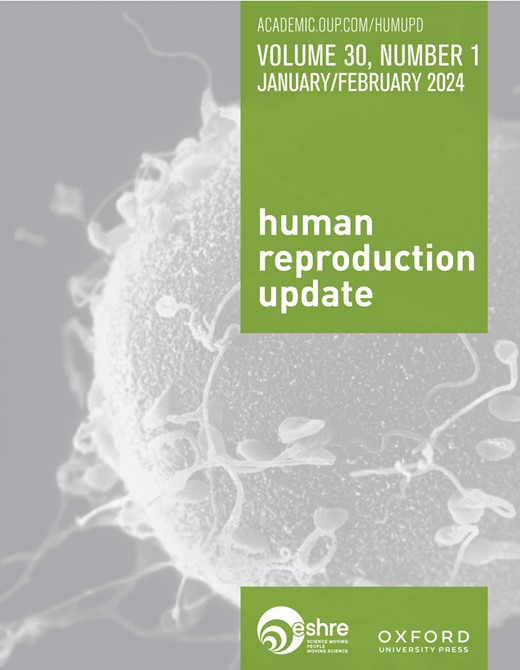手术诱发子宫内膜损伤相关的宫内粘连的流行病学、临床负担和预防:系统文献综述和选择性荟萃分析。
IF 16.1
1区 医学
Q1 OBSTETRICS & GYNECOLOGY
引用次数: 0
摘要
背景:育龄妇女子宫手术后出现宫腔粘连(IUAs)可能无症状,也可能出现月经清淡或缺经、不孕症、早产和/或围产期出血。了解手术和技术的特定风险以及手术佐剂影响的现有证据对未来研究的设计至关重要。目的与理由虽然已经发表了许多系统综述,但大多数都是针对问题的单一方面。因此,有必要进行大范围的系统评价和选择性荟萃分析,以确定证据的优势和差距,为未来的研究和治疗策略提供信息。检索方法系统回顾文献,寻找经选择子宫手术后IUA发生率的证据,以及宫腔镜粘连松解术对月经、子宫内膜、生育和妊娠相关结局的影响。一项评估旨在促进无粘连子宫内膜修复的手术佐剂的影响。按照PRISMA指南在PubMed、Embase和Cochrane数据库中进行检索,包括从成立到2024年11月8日的英语出版物。纳入标准限制了那些报道IUA流行病学或相关临床结果的文章。偏倚风险评估使用美国国立卫生研究院的工具进行干预性和观察性研究。荟萃分析只针对有足够数据的结果进行并报告。每项分析,我们报告了所纳入的每项研究的比例(95% CI)、异质性(I2)和偏倚风险。结果:该综述确定了249篇合适的出版物。早期妊娠流产、宫腔镜子宫肌瘤切除术和宫腔镜子宫成形术中间隔矫正后取出受精卵的风险分别为17% (95% CI: 11-25%; 13项研究,I2 = 87%,证据质量差至良好)、16% (95% CI: 6-28%; 8项研究,I2 = 93%,证据质量好至良好)和28% (95% CI: 13-46%; 8项研究,I2 = 91%,证据质量好至良好)。对于辅助宫内凝胶屏障预防原发性IUA,相对风险分别为0.45 (95% CI: 0.30-0.68;三项研究,I2 = 0%,证据质量差至良好)、0.38 (95% CI: 0.20-0.73;三项研究,I2 = 0%,证据质量一般)和0.29 (95% CI: 0.12-0.69;三项研究,I2 = 0%,证据质量一般至良好),遵循上述潜在粘连程序。无辅助粘连溶解后,IUA复发率为35% (95% CI: 24-46%; 13项研究,I2 = 95%,证据质量差到好),与辅助宫内球囊治疗(95% CI: 35-51%; 14项研究,I2 = 85%,证据质量差到好)或宫内节育器(95% CI: 27-59%; 4项研究,I2 = 85%,证据质量好到好)的43%相似。凝胶屏障二级预防的复发率为28% (95% CI: 4-62%; 3项研究,I2 = 94%,证据质量良好)。值得注意的是,相关的不良产科结果的发生率过高,包括早产、胎盘增生谱、前置胎盘、围产期出血和子宫切除术,有证据表明辅助治疗对这些结果有有益的影响。本系统综述全面分析子宫手术后IUA的形成和辅助治疗的效果。即使在粘连溶解后,很明显,被认为促进iua形成的基底子宫内膜创伤可能持续存在,并导致不利的生殖结果。在我们对子宫内膜损伤和宫内节育器的发病机制、预防和管理的认识上仍有许多关键的空白。注册号prospero (id: crd42023366218)。本文章由计算机程序翻译,如有差异,请以英文原文为准。
The epidemiology, clinical burden, and prevention of intrauterine adhesions (IUAs) related to surgically induced endometrial trauma: a systematic literature review and selective meta-analyses.
BACKGROUND
Reproductive-age women with intrauterine adhesions (IUAs) following uterine surgery may be asymptomatic or may experience light or absent menstruation, infertility, preterm delivery, and/or peripartum hemorrhage. Understanding procedure- and technique-specific risks and the available evidence on the impact of surgical adjuvants is essential to the design of future research.
OBJECTIVE AND RATIONALE
While many systematic reviews have been published, most deal with singular aspects of the problem. Consequently, a broadly scoped systematic review and selective meta-analyses identifying evidence strengths and gaps are necessary to inform future research and treatment strategies.
SEARCH METHODS
A systematic literature review was performed seeking evidence on IUA incidence following selected uterine procedures and the effectiveness of hysteroscopic adhesiolysis on menstrual, endometrial, fertility, and pregnancy-related outcomes. An evaluation of the impact of surgical adjuvants designed to facilitate adhesion-free endometrial repair was included. Searches were conducted in the PubMed, Embase, and Cochrane databases following PRISMA guidelines and included English-language publications from inception to 8 November 2024. Inclusion criteria restricted articles to those reporting IUA epidemiology or related clinical outcomes. Risk of bias assessment used the US NIH tools for interventional and observational studies. Meta-analyses were conducted and reported only for outcomes where there were sufficient data. Per analysis, we report on proportions (with 95% CI), heterogeneity (I2), and the risk of bias for each study included.
OUTCOMES
The review identified 249 appropriate publications. The risks of new-onset IUAs following the removal of products of conception after early pregnancy loss, hysteroscopic myomectomy, and hysteroscopic metroplasty for septum correction were 17% (95% CI: 11-25%; 13 studies, I2 = 87%, poor to good evidence quality), 16% (95% CI: 6-28%; 8 studies, I2 = 93%, fair to good evidence quality), and 28% (95% CI: 13-46%; 8 studies, I2 = 91%, fair to good evidence quality), respectively. For primary IUA prevention with adjuvant intrauterine gel barriers, the relative risks were 0.45 (95% CI: 0.30-0.68; three studies, I2 = 0%, poor to good evidence quality), 0.38 (95% CI: 0.20-0.73; three studies, I2 = 0%, fair evidence quality), and 0.29 (95% CI: 0.12-0.69; three studies, I2 = 0%, fair to good evidence quality), respectively, following the above potentially adhesiogenic procedures. Following adhesiolysis without adjuvants, the IUA recurrence rate was 35% (95% CI: 24-46%; 13 studies, I2 = 95%, poor to good evidence quality), similar to the rate of 43% for both those treated adjuvantly with an intrauterine balloon (95% CI: 35-51%; 14 studies, I2 = 85%, poor to good evidence quality), or an IUD (95% CI: 27-59%; four studies, I2 = 85%, fair to good evidence quality). The recurrence rate for secondary prevention with gel barriers was 28% (95% CI: 4-62%; three studies, I2 = 94%, good evidence quality). Notably, there was an excess rate of associated adverse obstetrical outcomes, including preterm delivery, placenta accreta spectrum, placenta previa, peripartum hemorrhage, and hysterectomy, with evidence demonstrating the beneficial impact of adjuvant therapies on these outcomes.
WIDER IMPLICATIONS
This systematic review comprehensively analyzes IUA formation following uterine surgical procedures and adjuvant therapy effectiveness. Even following adhesiolysis, it is apparent that the basilar endometrial trauma thought to facilitate the formation of IUAs may persist and contribute to adverse reproductive outcomes. Many critical gaps remain in our knowledge of the pathogenesis, prevention, and management of endometrial trauma and IUAs.
PREGISTRATION NUMBER
PROSPERO (ID: CRD42023366218).
求助全文
通过发布文献求助,成功后即可免费获取论文全文。
去求助
来源期刊

Human Reproduction Update
医学-妇产科学
CiteScore
28.80
自引率
1.50%
发文量
38
期刊介绍:
Human Reproduction Update is the leading journal in its field, boasting a Journal Impact FactorTM of 13.3 and ranked first in Obstetrics & Gynecology and Reproductive Biology (Source: Journal Citation ReportsTM from Clarivate, 2023). It specializes in publishing comprehensive and systematic review articles covering various aspects of human reproductive physiology and medicine.
The journal prioritizes basic, transitional, and clinical topics related to reproduction, encompassing areas such as andrology, embryology, infertility, gynaecology, pregnancy, reproductive endocrinology, reproductive epidemiology, reproductive genetics, reproductive immunology, and reproductive oncology. Human Reproduction Update is published on behalf of the European Society of Human Reproduction and Embryology (ESHRE), maintaining the highest scientific and editorial standards.
 求助内容:
求助内容: 应助结果提醒方式:
应助结果提醒方式:


